
A | B | C | D | E | F | G | H | CH | I | J | K | L | M | N | O | P | Q | R | S | T | U | V | W | X | Y | Z | 0 | 1 | 2 | 3 | 4 | 5 | 6 | 7 | 8 | 9


| Nuclear physics |
|---|
 |
Nuclear fusion is a reaction in which two or more atomic nuclei, usually deuterium and tritium (hydrogen isotopes), combine to form one or more different atomic nuclei and subatomic particles (neutrons or protons). The difference in mass between the reactants and products is manifested as either the release or absorption of energy. This difference in mass arises due to the difference in nuclear binding energy between the atomic nuclei before and after the reaction. Nuclear fusion is the process that powers active or main-sequence stars and other high-magnitude stars, where large amounts of energy are released.
A nuclear fusion process that produces atomic nuclei lighter than iron-56 or nickel-62 will generally release energy. These elements have a relatively small mass and a relatively large binding energy per nucleon. Fusion of nuclei lighter than these releases energy (an exothermic process), while the fusion of heavier nuclei results in energy retained by the product nucleons, and the resulting reaction is endothermic. The opposite is true for the reverse process, called nuclear fission. Nuclear fusion uses lighter elements, such as hydrogen and helium, which are in general more fusible; while the heavier elements, such as uranium, thorium and plutonium, are more fissionable. The extreme astrophysical event of a supernova can produce enough energy to fuse nuclei into elements heavier than iron.
History
American chemist William Draper Harkins was the first to propose the concept of nuclear fusion in 1915.[1][2] Then in 1921, Arthur Eddington suggested hydrogen–helium fusion could be the primary source of stellar energy.[3] Quantum tunneling was discovered by Friedrich Hund in 1927,[4][5] and shortly afterwards Robert Atkinson and Fritz Houtermans used the measured masses of light elements to demonstrate that large amounts of energy could be released by fusing small nuclei.[6] Building on the early experiments in artificial nuclear transmutation by Patrick Blackett, laboratory fusion of hydrogen isotopes was accomplished by Mark Oliphant in 1932.[7] In the remainder of that decade, the theory of the main cycle of nuclear fusion in stars was worked out by Hans Bethe. Research into fusion for military purposes began in the early 1940s as part of the Manhattan Project. Self-sustaining nuclear fusion was first carried out on 1 November 1952, in the Ivy Mike hydrogen (thermonuclear) bomb test.
While fusion was achieved in the operation of the hydrogen bomb (H-bomb), the reaction must be controlled and sustained in order for it to be a useful energy source. Research into developing controlled fusion inside fusion reactors has been ongoing since the 1930s, but the technology is still in its developmental phase.[8]
The US National Ignition Facility, which uses laser-driven inertial confinement fusion, was designed with a goal of break-even fusion; the first large-scale laser target experiments were performed in June 2009 and ignition experiments began in early 2011.[9][10] On 13 December 2022, the United States Department of Energy announced that on 5 December 2022, they had successfully accomplished break-even fusion, "delivering 2.05 megajoules (MJ) of energy to the target, resulting in 3.15 MJ of fusion energy output."[11]
Prior to this breakthrough, controlled fusion reactions had been unable to produce break-even (self-sustaining) controlled fusion.[12] The two most advanced approaches for it are magnetic confinement (toroid designs) and inertial confinement (laser designs). Workable designs for a toroidal reactor that theoretically will deliver ten times more fusion energy than the amount needed to heat plasma to the required temperatures are in development (see ITER). The ITER facility is expected to finish its construction phase in 2025. It will start commissioning the reactor that same year and initiate plasma experiments in 2025, but is not expected to begin full deuterium–tritium fusion until 2035.[13]
Private companies pursuing the commercialization of nuclear fusion received $2.6 billion in private funding in 2021 alone, going to many notable startups including but not limited to Commonwealth Fusion Systems, Helion Energy Inc., General Fusion, TAE Technologies Inc. and Zap Energy Inc.[14]
Process
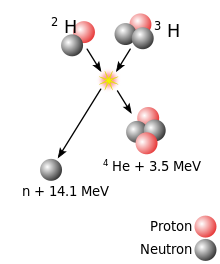
The release of energy with the fusion of light elements is due to the interplay of two opposing forces: the nuclear force, a manifestation of the strong interaction, which holds protons and neutrons tightly together in the atomic nucleus; and the Coulomb force, which causes positively charged protons in the nucleus to repel each other.[16] Lighter nuclei (nuclei smaller than iron and nickel) are sufficiently small and proton-poor to allow the nuclear force to overcome the Coulomb force. This is because the nucleus is sufficiently small that all nucleons feel the short-range attractive force at least as strongly as they feel the infinite-range Coulomb repulsion. Building up nuclei from lighter nuclei by fusion releases the extra energy from the net attraction of particles. For larger nuclei, however, no energy is released, because the nuclear force is short-range and cannot act across larger nuclei.
Fusion powers stars and produces virtually all elements in a process called nucleosynthesis. The Sun is a main-sequence star, and, as such, generates its energy by nuclear fusion of hydrogen nuclei into helium. In its core, the Sun fuses 620 million metric tons of hydrogen and makes 616 million metric tons of helium each second. The fusion of lighter elements in stars releases energy and the mass that always accompanies it. For example, in the fusion of two hydrogen nuclei to form helium, 0.645% of the mass is carried away in the form of kinetic energy of an alpha particle or other forms of energy, such as electromagnetic radiation.[17]
It takes considerable energy to force nuclei to fuse, even those of the lightest element, hydrogen. When accelerated to high enough speeds, nuclei can overcome this electrostatic repulsion and be brought close enough such that the attractive nuclear force is greater than the repulsive Coulomb force. The strong force grows rapidly once the nuclei are close enough, and the fusing nucleons can essentially "fall" into each other and the result is fusion and net energy produced. The fusion of lighter nuclei, which creates a heavier nucleus and often a free neutron or proton, generally releases more energy than it takes to force the nuclei together; this is an exothermic process that can produce self-sustaining reactions.[18]
Energy released in most nuclear reactions is much larger than in chemical reactions, because the binding energy that holds a nucleus together is greater than the energy that holds electrons to a nucleus. For example, the ionization energy gained by adding an electron to a hydrogen nucleus is 13.6 eV—less than one-millionth of the 17.6 MeV released in the deuterium–tritium (D–T) reaction shown in the adjacent diagram. Fusion reactions have an energy density many times greater than nuclear fission; the reactions produce far greater energy per unit of mass even though individual fission reactions are generally much more energetic than individual fusion ones, which are themselves millions of times more energetic than chemical reactions. Only direct conversion of mass into energy, such as that caused by the annihilatory collision of matter and antimatter, is more energetic per unit of mass than nuclear fusion. (The complete conversion of one gram of matter would release 9×1013 joules of energy.)
In stars
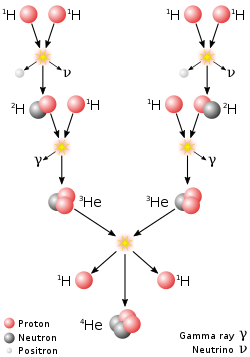
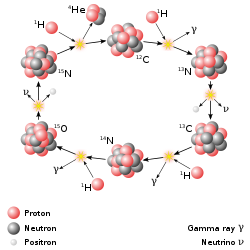
An important fusion process is the stellar nucleosynthesis that powers stars, including the Sun. In the 20th century, it was recognized that the energy released from nuclear fusion reactions accounts for the longevity of stellar heat and light. The fusion of nuclei in a star, starting from its initial hydrogen and helium abundance, provides that energy and synthesizes new nuclei. Different reaction chains are involved, depending on the mass of the star (and therefore the pressure and temperature in its core).
Around 1920, Arthur Eddington anticipated the discovery and mechanism of nuclear fusion processes in stars, in his paper The Internal Constitution of the Stars.[19][20] At that time, the source of stellar energy was unknown; Eddington correctly speculated that the source was fusion of hydrogen into helium, liberating enormous energy according to Einstein's equation E = mc2. This was a particularly remarkable development since at that time fusion and thermonuclear energy had not yet been discovered, nor even that stars are largely composed of hydrogen (see metallicity). Eddington's paper reasoned that:
- The leading theory of stellar energy, the contraction hypothesis, should cause the rotation of a star to visibly speed up due to conservation of angular momentum. But observations of Cepheid variable stars showed this was not happening.
- The only other known plausible source of energy was conversion of matter to energy; Einstein had shown some years earlier that a small amount of matter was equivalent to a large amount of energy.
- Francis Aston had also recently shown that the mass of a helium atom was about 0.8% less than the mass of the four hydrogen atoms which would, combined, form a helium atom (according to the then-prevailing theory of atomic structure which held atomic weight to be the distinguishing property between elements; work by Henry Moseley and Antonius van den Broek would later show that nucleic charge was the distinguishing property and that a helium nucleus, therefore, consisted of two hydrogen nuclei plus additional mass). This suggested that if such a combination could happen, it would release considerable energy as a byproduct.
- If a star contained just 5% of fusible hydrogen, it would suffice to explain how stars got their energy. (It is now known that most 'ordinary' stars contain far more than 5% hydrogen.)
- Further elements might also be fused, and other scientists had speculated that stars were the "crucible" in which light elements combined to create heavy elements, but without more accurate measurements of their atomic masses nothing more could be said at the time.
All of these speculations were proven correct in the following decades.
The primary source of solar energy, and that of similar size stars, is the fusion of hydrogen to form helium (the proton–proton chain reaction), which occurs at a solar-core temperature of 14 million kelvin. The net result is the fusion of four protons into one alpha particle, with the release of two positrons and two neutrinos (which changes two of the protons into neutrons), and energy. In heavier stars, the CNO cycle and other processes are more important. As a star uses up a substantial fraction of its hydrogen, it begins to synthesize heavier elements. The heaviest elements are synthesized by fusion that occurs when a more massive star undergoes a violent supernova at the end of its life, a process known as supernova nucleosynthesis.
Requirements
A substantial energy barrier of electrostatic forces must be overcome before fusion can occur. At large distances, two naked nuclei repel one another because of the repulsive electrostatic force between their positively charged protons. If two nuclei can be brought close enough together, however, the electrostatic repulsion can be overcome by the quantum effect in which nuclei can tunnel through coulomb forces.
When a nucleon such as a proton or neutron is added to a nucleus, the nuclear force attracts it to all the other nucleons of the nucleus (if the atom is small enough), but primarily to its immediate neighbors due to the short range of the force. The nucleons in the interior of a nucleus have more neighboring nucleons than those on the surface. Since smaller nuclei have a larger surface-area-to-volume ratio, the binding energy per nucleon due to the nuclear force generally increases with the size of the nucleus but approaches a limiting value corresponding to that of a nucleus with a diameter of about four nucleons. It is important to keep in mind that nucleons are quantum objects. So, for example, since two neutrons in a nucleus are identical to each other, the goal of distinguishing one from the other, such as which one is in the interior and which is on the surface, is in fact meaningless, and the inclusion of quantum mechanics is therefore necessary for proper calculations.
The electrostatic force, on the other hand, is an inverse-square force, so a proton added to a nucleus will feel an electrostatic repulsion from all the other protons in the nucleus. The electrostatic energy per nucleon due to the electrostatic force thus increases without limit as nuclei atomic number grows.
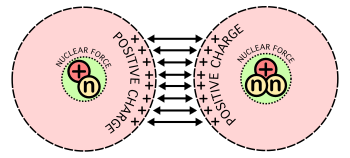
The net result of the opposing electrostatic and strong nuclear forces is that the binding energy per nucleon generally increases with increasing size, up to the elements iron and nickel, and then decreases for heavier nuclei. Eventually, the binding energy becomes negative and very heavy nuclei (all with more than 208 nucleons, corresponding to a diameter of about 6 nucleons) are not stable. The four most tightly bound nuclei, in decreasing order of binding energy per nucleon, are 62
Ni
, 58
Fe
, 56
Fe
, and 60
Ni
.[21] Even though the nickel isotope, 62
Ni
, is more stable, the iron isotope 56
Fe
is an order of magnitude more common. This is due to the fact that there is no easy way for stars to create 62
Ni
through the alpha process.
An exception to this general trend is the helium-4 nucleus, whose binding energy is higher than that of lithium, the next heavier element. This is because protons and neutrons are fermions, which according to the Pauli exclusion principle cannot exist in the same nucleus in exactly the same state. Each proton or neutron's energy state in a nucleus can accommodate both a spin up particle and a spin down particle. Helium-4 has an anomalously large binding energy because its nucleus consists of two protons and two neutrons (it is a doubly magic nucleus), so all four of its nucleons can be in the ground state. Any additional nucleons would have to go into higher energy states. Indeed, the helium-4 nucleus is so tightly bound that it is commonly treated as a single quantum mechanical particle in nuclear physics, namely, the alpha particle.
The situation is similar if two nuclei are brought together. As they approach each other, all the protons in one nucleus repel all the protons in the other. Not until the two nuclei actually come close enough for long enough so the strong attractive nuclear force can take over and overcome the repulsive electrostatic force. This can also be described as the nuclei overcoming the so-called Coulomb barrier. The kinetic energy to achieve this can be lower than the barrier itself because of quantum tunneling.
The Coulomb barrier is smallest for isotopes of hydrogen, as their nuclei contain only a single positive charge. A diproton is not stable, so neutrons must also be involved, ideally in such a way that a helium nucleus, with its extremely tight binding, is one of the products.
Using deuterium–tritium fuel, the resulting energy barrier is about 0.1 MeV. In comparison, the energy needed to remove an electron from hydrogen is 13.6 eV. The (intermediate) result of the fusion is an unstable 5He nucleus, which immediately ejects a neutron with 14.1 MeV. The recoil energy of the remaining 4He nucleus is 3.5 MeV, so the total energy liberated is 17.6 MeV. This is many times more than what was needed to overcome the energy barrier.
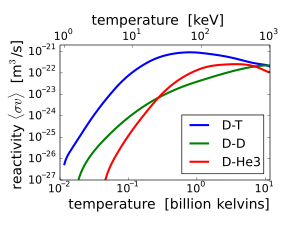
The reaction cross section (σ) is a measure of the probability of a fusion reaction as a function of the relative velocity of the two reactant nuclei. If the reactants have a distribution of velocities, e.g. a thermal distribution, then it is useful to perform an average over the distributions of the product of cross-section and velocity. This average is called the 'reactivity', denoted ⟨σv⟩. The reaction rate (fusions per volume per time) is ⟨σv⟩ times the product of the reactant number densities:
If a species of nuclei is reacting with a nucleus like itself, such as the DD reaction, then the product must be replaced by .
increases from virtually zero at room temperatures up to meaningful magnitudes at temperatures of 10–100 keV. At these temperatures, well above typical ionization energies (13.6 eV in the hydrogen case), the fusion reactants exist in a plasma state.
The significance of as a function of temperature in a device with a particular energy confinement time is found by considering the Lawson criterion. This is an extremely challenging barrier to overcome on Earth, which explains why fusion research has taken many years to reach the current advanced technical state.[22]
Artificial fusion
Thermonuclear fusion
Thermonuclear fusion is the process of atomic nuclei combining or "fusing" using high temperatures to drive them close enough together for this to become possible. Such temperatures cause the matter to become a plasma and, if confined, fusion reactions may occur due to collisions with extreme thermal kinetic energies of the particles. There are two forms of thermonuclear fusion: uncontrolled, in which the resulting energy is released in an uncontrolled manner, as it is in thermonuclear weapons ("hydrogen bombs") and in most stars; and controlled, where the fusion reactions take place in an environment allowing some or all of the energy released to be harnessed for constructive purposes.
Temperature is a measure of the average kinetic energy of particles, so by heating the material it will gain energy. After reaching sufficient temperature, given by the Lawson criterion, the energy of accidental collisions within the plasma is high enough to overcome the Coulomb barrier and the particles may fuse together.
In a deuterium–tritium fusion reaction, for example, the energy necessary to overcome the Coulomb barrier is 0.1 MeV. Converting between energy and temperature shows that the 0.1 MeV barrier would be overcome at a temperature in excess of 1.2 billion kelvin.
There are two effects that are needed to lower the actual temperature. One is the fact that temperature is the average kinetic energy, implying that some nuclei at this temperature would actually have much higher energy than 0.1 MeV, while others would be much lower. It is the nuclei in the high-energy tail of the velocity distribution that account for most of the fusion reactions. The other effect is quantum tunnelling. The nuclei do not actually have to have enough energy to overcome the Coulomb barrier completely. If they have nearly enough energy, they can tunnel through the remaining barrier. For these reasons fuel at lower temperatures will still undergo fusion events, at a lower rate.
Thermonuclear fusion is one of the methods being researched in the attempts to produce fusion power. If thermonuclear fusion becomes favorable to use, it would significantly reduce the world's carbon footprint.
Beam–beam or beam–target fusion
Accelerator-based light-ion fusion is a technique using particle accelerators to achieve particle kinetic energies sufficient to induce light-ion fusion reactions.[23]
Accelerating light ions is relatively easy, and can be done in an efficient manner—requiring only a vacuum tube, a pair of electrodes, and a high-voltage transformer; fusion can be observed with as little as 10 kV between the electrodes.[citation needed] The system can be arranged to accelerate ions into a static fuel-infused target, known as beam–target fusion, or by accelerating two streams of ions towards each other, beam–beam fusion.[citation needed] The key problem with accelerator-based fusion (and with cold targets in general) is that fusion cross sections are many orders of magnitude lower than Coulomb interaction cross-sections. Therefore, the vast majority of ions expend their energy emitting bremsstrahlung radiation and the ionization of atoms of the target. Devices referred to as sealed-tube neutron generators are particularly relevant to this discussion. These small devices are miniature particle accelerators filled with deuterium and tritium gas in an arrangement that allows ions of those nuclei to be accelerated against hydride targets, also containing deuterium and tritium, where fusion takes place, releasing a flux of neutrons. Hundreds of neutron generators are produced annually for use in the petroleum industry where they are used in measurement equipment for locating and mapping oil reserves.[citation needed]
A number of attempts to recirculate the ions that "miss" collisions have been made over the years. One of the better-known attempts in the 1970s was Migma, which used a unique particle storage ring to capture ions into circular orbits and return them to the reaction area. Theoretical calculations made during funding reviews pointed out that the system would have significant difficulty scaling up to contain enough fusion fuel to be relevant as a power source. In the 1990s, a new arrangement using a field-reversed configuration (FRC) as the storage system was proposed by Norman Rostoker and continues to be studied by TAE Technologies as of 2021[update]. A closely related approach is to merge two FRC's rotating in opposite directions,[24] which is being actively studied by Helion Energy. Because these approaches all have ion energies well beyond the Coulomb barrier, they often suggest the use of alternative fuel cycles like p-11B that are too difficult to attempt using conventional approaches.[25]
Muon-catalyzed fusion
Muon-catalyzed fusion is a fusion process that occurs at ordinary temperatures. It was studied in detail by Steven Jones in the early 1980s. Net energy production from this reaction has been unsuccessful because of the high energy required to create muons, their short 2.2 μs half-life, and the high chance that a muon will bind to the new alpha particle and thus stop catalyzing fusion.[26]
Other principles
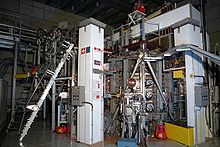
Some other confinement principles have been investigated.
- Antimatter-initialized fusion uses small amounts of antimatter to trigger a tiny fusion explosion. This has been studied primarily in the context of making nuclear pulse propulsion, and pure fusion bombs feasible. This is not near becoming a practical power source, due to the cost of manufacturing antimatter alone.
- Pyroelectric fusion was reported in April 2005 by a team at UCLA. The scientists used a pyroelectric crystal heated from −34 to 7 °C (−29 to 45 °F), combined with a tungsten needle to produce an electric field of about 25 gigavolts per meter to ionize and accelerate deuterium nuclei into an erbium deuteride target. At the estimated energy levels,[27] the D–D fusion reaction may occur, producing helium-3 and a 2.45 MeV neutron. Although it makes a useful neutron generator, the apparatus is not intended for power generation since it requires far more energy than it produces.[28][29][30][31] D–T fusion reactions have been observed with a tritiated erbium target.[32]
- Nuclear fusion–fission hybrid (hybrid nuclear power) is a proposed means of generating power by use of a combination of nuclear fusion and fission processes. The concept dates to the 1950s, and was briefly advocated by Hans Bethe during the 1970s, but largely remained unexplored until a revival of interest in 2009, due to the delays in the realization of pure fusion.[33]
- Project PACER, carried out at Los Alamos National Laboratory (LANL) in the mid-1970s, explored the possibility of a fusion power system that would involve exploding small hydrogen bombs (fusion bombs) inside an underground cavity. As an energy source, the system is the only fusion power system that could be demonstrated to work using existing technology. However it would also require a large, continuous supply of nuclear bombs, making the economics of such a system rather questionable.
- Bubble fusion also called sonofusion was a proposed mechanism for achieving fusion via sonic cavitation which rose to prominence in the early 2000s. Subsequent attempts at replication failed and the principal investigator, Rusi Taleyarkhan, was judged guilty of research misconduct in 2008.[34]
Confinement in thermonuclear fusion
The key problem in achieving thermonuclear fusion is how to confine the hot plasma. Due to the high temperature, the plasma cannot be in direct contact with any solid material, so it has to be located in a vacuum. Also, high temperatures imply high pressures. The plasma tends to expand immediately and some force is necessary to act against it. This force can take one of three forms: gravitation in stars, magnetic forces in magnetic confinement fusion reactors, or inertial as the fusion reaction may occur before the plasma starts to expand, so the plasma's inertia is keeping the material together.
Gravitational confinement
One force capable of confining the fuel well enough to satisfy the Lawson criterion is gravity. The mass needed, however, is so great that gravitational confinement is only found in stars—the least massive stars capable of sustained fusion are red dwarfs, while brown dwarfs are able to fuse deuterium and lithium if they are of sufficient mass. In stars heavy enough, after the supply of hydrogen is exhausted in their cores, their cores (or a shell around the core) start fusing helium to carbon. In the most massive stars (at least 8–11 solar masses), the process is continued until some of their energy is produced by fusing lighter elements to iron. As iron has one of the highest binding energies, reactions producing heavier elements are generally endothermic. Therefore, significant amounts of heavier elements are not formed during stable periods of massive star evolution, but are formed in supernova explosions. Some lighter stars also form these elements in the outer parts of the stars over long periods of time, by absorbing energy from fusion in the inside of the star, by absorbing neutrons that are emitted from the fusion process.
All of the elements heavier than iron have some potential energy to release, in theory. At the extremely heavy end of element production, these heavier elements can produce energy in the process of being split again back toward the size of iron, in the process of nuclear fission. Nuclear fission thus releases energy that has been stored, sometimes billions of years before, during stellar nucleosynthesis.
Magnetic confinement
Electrically charged particles (such as fuel ions) will follow magnetic field lines (see Guiding centre). The fusion fuel can therefore be trapped using a strong magnetic field. A variety of magnetic configurations exist, including the toroidal geometries of tokamaks and stellarators and open-ended mirror confinement systems.
Inertial confinement
A third confinement principle is to apply a rapid pulse of energy to a large part of the surface of a pellet of fusion fuel, causing it to simultaneously "implode" and heat to very high pressure and temperature. If the fuel is dense enough and hot enough, the fusion reaction rate will be high enough to burn a significant fraction of the fuel before it has dissipated. To achieve these extreme conditions, the initially cold fuel must be explosively compressed. Inertial confinement is used in the hydrogen bomb, where the driver is x-rays created by a fission bomb. Inertial confinement is also attempted in "controlled" nuclear fusion, where the driver is a laser, ion, or electron beam, or a Z-pinch. Another method is to use conventional high explosive material to compress a fuel to fusion conditions.[35][36] The UTIAS explosive-driven-implosion facility was used to produce stable, centred and focused hemispherical implosions[37] to generate neutrons from D-D reactions. The simplest and most direct method proved to be in a predetonated stoichiometric mixture of deuterium-oxygen. The other successful method was using a miniature Voitenko compressor,[38] where a plane diaphragm was driven by the implosion wave into a secondary small spherical cavity that contained pure deuterium gas at one atmosphere.[39]
Electrostatic confinement
There are also electrostatic confinement fusion devices. These devices confine ions using electrostatic fields. The best known is the fusor. This device has a cathode inside an anode wire cage. Positive ions fly towards the negative inner cage, and are heated by the electric field in the process. If they miss the inner cage they can collide and fuse. Ions typically hit the cathode, however, creating prohibitory high conduction losses. Also, fusion rates in fusors are very low due to competing physical effects, such as energy loss in the form of light radiation.[40] Designs have been proposed to avoid the problems associated with the cage, by generating the field using a non-neutral cloud. These include a plasma oscillating device,[41] a Penning trap and the polywell.[42] The technology is relatively immature, however, and many scientific and engineering questions remain.
The most well known Inertial electrostatic confinement approach is the fusor. Starting in 1999, a number of amateurs have been able to do amateur fusion using these homemade devices.[43][44][45][46] Other IEC devices include: the Polywell, MIX POPS[47] and Marble concepts.[48]
Important reactions
Stellar reaction chains
At the temperatures and densities in stellar cores, the rates of fusion reactions are notoriously slow. For example, at solar core temperature (T ≈ 15 MK) and density (160 g/cm3), the energy release rate is only 276 μW/cm3—about a quarter of the volumetric rate at which a resting human body generates heat.[49] Thus, reproduction of stellar core conditions in a lab for nuclear fusion power production is completely impractical. Because nuclear reaction rates depend on density as well as temperature and most fusion schemes operate at relatively low densities, those methods are strongly dependent on higher temperatures. The fusion rate as a function of temperature (exp(−E/kT)), leads to the need to achieve temperatures in terrestrial reactors 10–100 times higher than in stellar interiors: T ≈ (0.1–1.0)×109 K.
Criteria and candidates for terrestrial reactions
In artificial fusion, the primary fuel is not constrained to be protons and higher temperatures can be used, so reactions with larger cross-sections are chosen. Another concern is the production of neutrons, which activate the reactor structure radiologically, but also have the advantages of allowing volumetric extraction of the fusion energy and tritium breeding. Reactions that release no neutrons are referred to as aneutronic.
To be a useful energy source, a fusion reaction must satisfy several criteria. It must:
- Be exothermic
- This limits the reactants to the low Z (number of protons) side of the curve of binding energy. It also makes helium 4
He
the most common product because of its extraordinarily tight binding, although 3
He
and 3
H
also show up. - Involve low atomic number (Z) nuclei
- This is because the electrostatic repulsion that must be overcome before the nuclei are close enough to fuse ( Coulomb barrier ) is directly related to the number of protons it contains – its atomic number.
- Have two reactants
- At anything less than stellar densities, three-body collisions are too improbable. In inertial confinement, both stellar densities and temperatures are exceeded to compensate for the shortcomings of the third parameter of the Lawson criterion, ICF's very short confinement time.
- Have two or more products
- This allows simultaneous conservation of energy and momentum without relying on the electromagnetic force.
- Conserve both protons and neutrons
- The cross sections for the weak interaction are too small.
Few reactions meet these criteria. The following are those with the largest cross sections:[50] [51]
(1) 2
1D
+ 3
1T
→ 4
2He
( 3.52 MeV ) + n0 ( 14.06 MeV ) (2i) 2
1D
+ 2
1D
→ 3
1T
( 1.01 MeV ) + p+ ( 3.02 MeV ) 50% (2ii) → 3
2He
( 0.82 MeV ) + n0 ( 2.45 MeV ) 50% (3) 2
1D
+ 3
2He
→ 4
2He
( 3.6 MeV ) + p+ ( 14.7 MeV ) (4) 3
1T
+ 3
1T
→ 4
2He
+ 2 n0 + 11.3 MeV (5) 3
2He
+ 3
2He
→ 4
2He
+ 2 p+ + 12.9 MeV (6i) 3
2He
+ 3
1T
→ 4
2He
+ p+ + n0 + 12.1 MeV 57% (6ii) → 4
2He
( 4.8 MeV ) + 2
1D
( 9.5 MeV ) 43% (7i) 2
1D
+ 6
3Li
→ 2 4
2He
+ 22.4 MeV (7ii) → 3
2He
+ 4
2He
+ n0 + 2.56 MeV (7iii) → 7
3Li
+ p+ + 5.0 MeV (7iv) → 7
4Be
+ n0
Text je dostupný za podmienok Creative Commons Attribution/Share-Alike License 3.0 Unported; prípadne za ďalších podmienok. Podrobnejšie informácie nájdete na stránke Podmienky použitia.
Analytika
Antropológia
Aplikované vedy
Bibliometria
Dejiny vedy
Encyklopédie
Filozofia vedy
Forenzné vedy
Humanitné vedy
Knižničná veda
Kryogenika
Kryptológia
Kulturológia
Literárna veda
Medzidisciplinárne oblasti
Metódy kvantitatívnej analýzy
Metavedy
Metodika
Text je dostupný za podmienok Creative Commons Attribution/Share-Alike License 3.0 Unported; prípadne za ďalších podmienok.
Podrobnejšie informácie nájdete na stránke Podmienky použitia.
www.astronomia.sk | www.biologia.sk | www.botanika.sk | www.dejiny.sk | www.economy.sk | www.elektrotechnika.sk | www.estetika.sk | www.farmakologia.sk | www.filozofia.sk | Fyzika | www.futurologia.sk | www.genetika.sk | www.chemia.sk | www.lingvistika.sk | www.politologia.sk | www.psychologia.sk | www.sexuologia.sk | www.sociologia.sk | www.veda.sk I www.zoologia.sk




